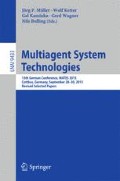Abstract
Automotive companies tend to apply modular approaches in their product development processes in order to save costs and meet increasingly diversified customer demands. In largely decentralized environments with cross-branded development projects over multiple departments in different sites this modular approach leads to very complex and large data structures. Maintaining consistency and transparency, as well as coordinating information flows in such an environment is a major task which is often accomplished manually. Based on a real world case study, this paper analyzes a key development process: the connection of geometric (geometries) and logistical data (parts). During this time consuming process information carriers (geometries and parts) with independent lifecycles that are maintained by different stakeholders (designer and purchaser) of different departments (and in this scenario even within multiple brands) are linked as these carriers themselves are mutually dependent. This paper then proceeds to model five agent-based architecture variants to support this process. In addition, an algorithm to map geometric and logistical data which aims to relieve the actors involved (regarding the organizational overhead) is outlined.The paper concludes with a comparison of the different agent architecture variants and emphasizes the most promising variants to partly automate the connection of geometric and logistical data.
Access this chapter
Tax calculation will be finalised at checkout
Purchases are for personal use only
Notes
- 1.
It should be noted that the function property is optional as not every component fulfills a specific function. For example, a simple screw that is used a few hundred times across different locations within a vehicle. It does to some extend contribute to several functions but cannot be connected to one specific function.
- 2.
Depending on the architecture variant this could be the Extended Component, Extended Context or (Extended) Usage Agent.
- 3.
It should be noted that the whole communication part does not apply to Architecture Variant IV because there is only one agent (the Extended Context Agent) which handles the mapping negotiations internally.
- 4.
Engineers and Purchasers.
References
Cheng, H., Chu, X.: A network-based assessment approach for change impacts on complex product. J. Intell. Manuf. 23(4), 1419–1431 (2012). http://dx.doi.org/10.1007/s10845-010-0454-8
Clarkson, J.P., Simons, C., Eckert, C.: Predicting change propagation in complex design. In: ASME 2001 Design Engineering Technical Conferences and Computers and Information in Engineering Conference. Pittsburgh, Pennsylvania (2001)
Fricke, E., Gebhard, B., Negele, H., Igenbergs, E.: Coping with changes: Causes, findings, and strategies. Syst. Eng. 3(4), 169–179 (2000)
Glauche, M., Rebel, M., Müller, J.P.: Produktstrukturierung als Erfolgsfaktor: Systematisierung und Analyse von Einflussfaktoren der Produktstrukturierung. ZWF - Zeitschrift für wirtschaftlichen Fabrikbetrieb 11, 878–881 (2013)
Jarratt, T., Eckert, C.M., Caldwell, N., Clarkson, P.J.: Engineering change: an overview and perspective on the literature. Res. Eng. Des. 22(2), 103–124 (2011). http://dx.doi.org/10.1007/s00163-010-0097-y
Kehl, S., Stiefel, P., Müller, J.P.: Changes on changes: Towards an agent-based approach for managing complexity in decentralized product development. In: International Conference on Engineering Design (ICED 15). vol. 3, pp. 220–228. Milan, Italy (2015)
Lamport, L.: The part-time parliament. ACM Trans. Comput. Syst. 16(2), 133–169 (1998)
Michael Wooldridge: An Introduction to MultiAgent Systems. John Wiley & Sons, 2 edn (2009)
Ongaro, D., Ousterhout, J.: In search of an understandable consensus algorithm. In: Proceedings of the 2014 USENIX Conference on USENIX Annual Technical Conference. pp. 305–320. USENIX ATC 2014, USENIX Association, Berkeley, CA, USA (2014). http://dl.acm.org/citation.cfm?id=2643634.2643666
Simon, H.A.: The sciences of the artificial, vol. 3. MIT Press, Cambridge (1996)
Tseng, M.M., Jiao, J.: Mass customization: 25. In: Handbook of Industrial Engineering, pp. 684–709. John Wiley & Sons, Inc (2007). http://dx.doi.org/10.1002/9780470172339.ch25
Verband der Automobilindustrie (VDA): Auto 2008 - jahresbericht. online (July 2008).www.vda.de/de/services/Publikationen/Publikation.489.html
Verband der Automobilindustrie (VDA): Jahresbericht 2012. online (July 2012). https://www.vda.de/de/services/Publikationen/jahresbericht-2012.html
Verband der Automobilindustrie (VDA): Jahresbericht 2013. online (August 2013). https://www.vda.de/de/services/Publikationen/jahresbericht-2013.html
Wagner, T.: Agentenunterstütztes engineering von automatisierungsanlagen. atp-online Automatisierungstechnische. Praxis 50(4), 68–75 (2008)
Xu, H.C., Xu, X.F., He, T.: Research on transformation engineering bom into manufacturing bom based on bop. Appl. Mech. Mater. 10–12, 99–103 (2008)
Author information
Authors and Affiliations
Corresponding author
Editor information
Editors and Affiliations
Rights and permissions
Copyright information
© 2015 Springer International Publishing Switzerland
About this paper
Cite this paper
Bender, J., Kehl, S., Müller, J.P. (2015). A Comparison of Agent-Based Coordination Architecture Variants for Automotive Product Change Management. In: Müller, J., Ketter, W., Kaminka, G., Wagner, G., Bulling, N. (eds) Multiagent System Technologies . MATES 2015. Lecture Notes in Computer Science(), vol 9433. Springer, Cham. https://doi.org/10.1007/978-3-319-27343-3_14
Download citation
DOI: https://doi.org/10.1007/978-3-319-27343-3_14
Published:
Publisher Name: Springer, Cham
Print ISBN: 978-3-319-27342-6
Online ISBN: 978-3-319-27343-3
eBook Packages: Computer ScienceComputer Science (R0)

